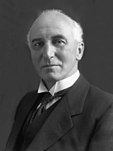1935 United Kingdom general election in Scotland
| |||||||||||||||||||||||||||||||||||||||||
All 74 Scottish seats to the House of Commons | |||||||||||||||||||||||||||||||||||||||||
|---|---|---|---|---|---|---|---|---|---|---|---|---|---|---|---|---|---|---|---|---|---|---|---|---|---|---|---|---|---|---|---|---|---|---|---|---|---|---|---|---|---|
| |||||||||||||||||||||||||||||||||||||||||
 Results of the 1935 election in Scotland for the county and burgh seats Unionist Labour Independent Labour Party National Liberal Liberal Communist Party of Great Britain | |||||||||||||||||||||||||||||||||||||||||
A general election was held in the United Kingdom was held on Thursday 14 November 1935, and all 74 seats in Scotland were contested.[1] When combined with results from across the UK, the election resulted in a second (though reduced) landslide victory for the three-party National Government, which was led by Stanley Baldwin of the Conservative Party after the resignation of Ramsay MacDonald due to ill health earlier in the year. It is the most recent British general election to have seen any party or alliance of parties win a majority of the popular vote. Due to the outbreak of the Second World War in 1939 the next general election was not held until 1945.
Scotland was allocated 74 seats in the House of Commons, with 71 territorial seats (32 burgh constituencies and 38 county constituencies). There was also one university constituency, which elected an additional 3 members using the Single Transferable Vote (STV) method.[2] As voters in university constituencies voted under a different system, and in addition to their territorial vote, the results are compiled separately.
In Scotland, the three parties forming the National Government collectively lost seats, predominantly to the Labour Party. The National Government also lost seats compared to the previous election as a result of the Liberals leaving government in 1932 following the adoption of a protectionist policy caused by the government negotiating the Ottawa Accords.[3] The election saw the Independent Labour Party gaining 4 Scottish seats in its first outing as a standalone party. Previously affiliated to Labour, it had since the previous election been increasingly moved apart from them, ultimately dissociating from the party in March 1932. The ILP had dominated the Labour movement in Scotland since 1918, dominating community based activism, and essentially forming the Labour Party in Scotland. This had ultimately served to undermine the organisational growth of the Labour Party in Scotland.[4] The election was the first general election to be contested by the Scottish National Party, and the Communist Party gained its first seat in ten years, taking West Fife.
Results
[edit]Seats summary
[edit]| Party | Seats | Last Election | Seats change | ||
|---|---|---|---|---|---|
| National Government (Total) | 46 | 67 | |||
| Unionist | 37 | 50 | |||
| National Liberal & Conservative | 8 | 8 | |||
| National Labour | 1 | 1 | |||
| Labour Party | 20 | 7 | |||
| Independent Labour Party | 4 | New | New | ||
| Liberal | 3 | 8 | |||
| Communist | 1 | 0 | |||
| Total | 74 | 74 | |||
Burgh & County constituencies
[edit]| Party | Seats | Seats change | Votes | % | % Change | ||
|---|---|---|---|---|---|---|---|
| National Government (Total) | 43 | 1,135,403 | 49.8 | ||||
| Unionist | 35 | 962,595 | 42.0 | ||||
| National Liberal | 7 | 149,072 | 6.7 | ||||
| National Labour | 1 | 19,115 | 0.9 | ||||
| National | 0 | N/A | 4,621 | 0.2 | N/A | ||
| Labour Party | 20 | 863,789 | 36.8 | ||||
| Liberal | 3 | 174,235 | 6.7 | ||||
| Independent Labour Party | 4 | N/A | 111,256 | 5.0 | N/A | ||
| SNP | 0 | N/A | 25,652 | 1.1 | N/A | ||
| Communist | 1 | 13,462 | 0.6 | ||||
| Total | 71 | 2,323,797 | 100 | ||||
University constituency
[edit]The Combined Scottish Universities elected an additional 3 members to the house using the STV voting method. Note that there was no election in 1931 as only three candidates stood for election.
| Party | Seats | Seats change | First Preference Votes | % | % Change | ||
|---|---|---|---|---|---|---|---|
| National Government (Total) | 3 | 23,260 | 85.8 | N/A | |||
| Unionist | 2 | 15,731 | 58.0 | N/A | |||
| National Liberal | 1 | 7,529 | 27.8 | N/A | |||
| SNP | 0 | New | 3,865 | 14.3 | N/A | ||
| Total | 3 | 27,125 | 100 | ||||
Votes summary
[edit]Notes
[edit]References
[edit]- ^ As per Boundaries of Parliamentary Constituencies 1885-1972 (ISBN 0-900178-09-4), F. W. S. Craig 1972, except Graig omits indication that the burgh of Renfrew was not entirely within the county of the same name
- ^ "Research Briefing: Voting systems in the UK". Library of the House of Commons. 10 January 2023. Retrieved 26 November 2024.
- ^ "Resignation letter by Liberal ministers to Ramsay MacDonald". Letter to Ramsay MacDonald. Samuel papers. 28 September 1932. SAM/A/89/84.
{{cite press release}}: CS1 maint: others (link) - ^ William Kenefick (2007). Red Scotland!: The Rise and Fall of the Radical Left, C. 1872–1932. Edinburgh University Press. pp. 202–203. ISBN 978-0-7486-2517-8.



